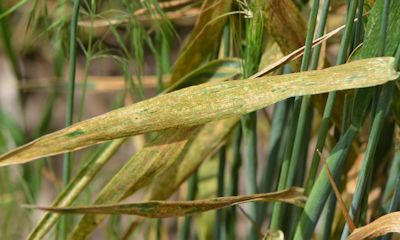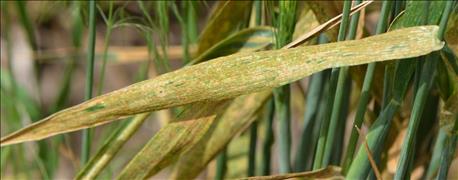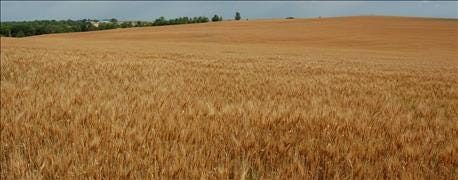June 7, 2016

Stripe rust has significantly increased in all wheat-growing areas in Nebraska. It is recommended that wheat be treated with a fungicide to protect the flag leaf. If the incidence (percentage of flag leaves diseased) or severity (percentage of the flag leaf area diseased) is less than 50%, spraying a fungicide will significantly reduce yield loss due to stripe rust.

STRIPE RUST INCREASING: A flag leaf completely covered with stripe rust in a grower's field in Nuckolls County on May 25.
What are your options?
For wheat that is fully headed or flowering, growers should apply a triazole fungicide (a fungicide whose active ingredient ends in "…conazole" in the following table: Fungicide Efficacy for Control of Wheat Diseases, compiled by the North Central Regional Committee on Management of Small Grain Diseases (NCERA-184). If wheat is not headed or is just beginning to head, apply any fungicide labeled for rust control on wheat.
Applying a generic fungicide will save some money. Generic Folicur (active ingredient: tebuconazole) is recommended as it has excellent efficacy on rust diseases and fair efficacy on Fusarium head blight.
In high risk areas for Fusarium head blight, which include eastern and southern Nebraska, Caramba or Prosaro is recommended for control of stripe rust and suppression of Fusarium head blight.
It's too late to spray wheat fields that are well past the flowering growth stage or those where flag leaves are already heavily infected by stripe rust, like the one shown the picture below.

FIELD TOURS: Wheat variety field tours are being held at six sites in the Panhandle and west central Nebraska June 13-15.
Although warmer daytime temperatures (greater than 75 degrees F) can slow stripe rust development, cool nighttime temperatures coupled with dew formation and intermittent rain are favorable conditions for development and spread of stripe rust. So, don't rely on warmer temperatures alone to slow stripe rust. It's recommended that wheat be treated with a fungicide to protect the flag leaf.
For more information, contact Stephen Wegulo, University of Nebraska Extension plant pathologist at [email protected].
Wheat variety field tours coming up
In other wheat news, wheat variety field tours are being held at six sites in the Panhandle and west central Nebraska this month.
Wheat variety field tour sites include:
• June 13 at 6 p.m. – Deuel County rainfed site near Chappell
• June 14 at 8 a.m. – UNL High Plains Ag Lab Field Day, Cheyenne County rainfed site near Sidney
• June 14 at 4 p.m. – Box Butte County irrigated site near Hemingford
• June 14 at 6 p.m. – Box Butte County rainfed site near Hemingford
• June 15, 8 a.m. to 2:30 p.m. – Henry J. Stumpf International Wheat Research Program Wheat and Field Pea Plot Tour near Grant.
• June 15 at 5 p.m. – Furnas County near Beaver City.
For more information and specific site locations, visit cropwatch.unl.edu.
Source: UNL CropWatch
You May Also Like




